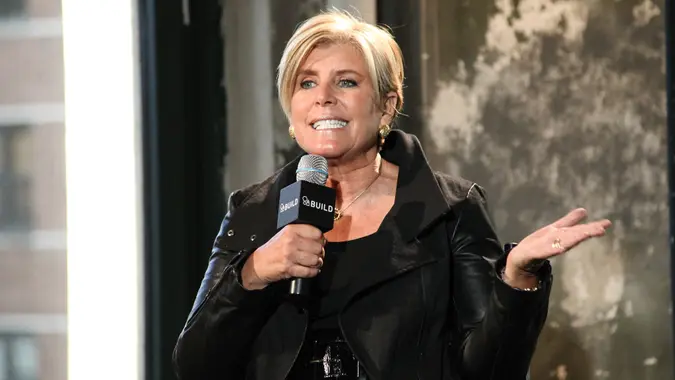How Does Robinhood Make Money? Revenue Streams Explained

Commitment to Our Readers
GOBankingRates' editorial team is committed to bringing you unbiased reviews and information. We use data-driven methodologies to evaluate financial products and services - our reviews and ratings are not influenced by advertisers. You can read more about our editorial guidelines and our products and services review methodology.

20 Years
Helping You Live Richer

Reviewed
by Experts

Trusted by
Millions of Readers
Robinhood pioneered the commission-free trading revolution that democratized investing, which had previously been a prohibitively costly endeavor reserved only for those who could afford to put their money in play.
However, the online brokerage is hardly a charity. In Q1 2025, it reported 50% year-over-year revenue growth to $927 million, net deposit growth reaching a record $18.0 billion, and 114% net income growth to $336 million.
So if it’s free to use, how does Robinhood make money? Read on.
Payment for Order Flow (PFOF)
Firms known as market makers facilitate trading by executing trades at publicly quoted prices. They profit from the spread, which is the difference between the bid and ask (or buy and sell) prices. They purchase their piece of the action by paying brokerages like Robinhood a few cents per trade, which Robinhood uses to offset the revenue lost from the fees it doesn’t charge.
The process is known as payment for order flow, or PFOF, and it provides essential market liquidity and ensures quick, accurate transactions. However, the role of market makers is not without controversy. Their detractors argue that their involvement reduces transparency and creates a conflict of interest that incentivizes brokerages to prioritize market maker payments over securing the best possible prices for their clients.
Robinhood Gold (Premium Subscriptions)
Robinhood also compensates for lost broker commissions by offering optional premium subscription services, which generate recurring revenue — a lot of it. The Robinhood Gold subscriber base increased by 90%, or 1.5 million, year-over-year to 3.2 million in Q1 2025, accounting for most of the company’s 54% increase growth in non-interest and non-transaction revenue.
For $5 a month or $50 per year, Robinhood Gold members get:
- Larger instant deposit amounts
- Lower fees for index options trades
- Access to Morningstar professional research and Level II market data from Nasdaq
- No interest on the first $1,000 of margin borrowing
- Discounted futures trading commissions
- High-yield APY on uninvested brokerage cash
Interest on Uninvested Cash
Robinhood pays a comparatively high yield on uninvested cash to its 3.2 million Gold subscribers by transferring it to its FDIC-insured partner banks through its Cash Sweep program. The APY, which can fluctuate, is currently 4%.
However, Robinhood collects that interest for itself on the cash sitting idle in its 22 million non-Gold accounts. In the year ending in Q1 2025, Robinhood’s Cash Sweep increased by 48% to a record $28.2 billion.
Margin Lending
Those with margin accounts can use their holdings to secure loans from Robinhood to reinvest. It’s a risky strategy that can result in greater gains, but also magnified losses. If the value of your holdings falls below a certain threshold, borrowers may be issued a margin call, requiring them to pay or forfeit their collateralized securities.
Robinhood earns between 4.7% and 5.75% on those loans.
Securities Lending
Robinhood earns money and offers qualified users the opportunity to do the same by lending their fully owned stock shares to borrowers, such as hedge funds and market makers, which use them to cover shortages. It lends shares only from those who authorize it by enabling the Stock Lending feature on the app, then divides the proceeds from the borrower fees between itself and the share owner.
Rebates from Cash Card and Spending Products
The Robinhood Cash card is a prepaid debit card that helps cardholders invest in crypto and stocks as they spend with roundups and cash back from participating brands. Other perks include early direct deposit and direct investment from your paycheck. There are no monthly, overdraft or minimum balance fees and standard ACH bank transfers are free.
However, users might face a 1.75% fee for instant withdrawals to a bank account or debit card. The charge is a minimum of $1 and a maximum of $150 per transaction.
Cryptocurrency Trading Fees
Stock trading is free on Robinhood, but with crypto trades, the platform harvests the spread, the difference between the estimated buy and sell price. While not a direct charge, it serves as a fee in practice.
Robinhood’s transaction-based revenues increased 77% to $583 million in the year ending in the first quarter of 2025. Cryptocurrency fees were the prime driver, with revenue up 100% to $252 million.
The trading platform supports popular coins like Bitcoin, Ethereum and Dogecoin.
IPO Access and Other Products
Robinhood also pads its bottom line through:
- IPO access: Investment banks that underwrite initial public offerings give Robinhood shares to sell to its users.
- Retirement accounts: Robinhood offers both self-directed and actively managed IRAs and Roth IRAs. Managed accounts come with a 0.25% fee.
- Credit cards: There’s currently a waitlist for the Robinhood Gold credit card. Approved applicants won’t pay an annual fee, but those who run a revolving balance will face the high interest rates associated with all credit cards.
Criticisms and Transparency
Criticism of the Robinhood business model is not limited to the market makers that serve many other brokerages.
- Outages, operational issues and breach threats have triggered regulatory scrutiny and charges that Robinhood didn’t do enough to protect customers’ identities.
- Investors complained about its decision to halt trading during the GameStop frenzy and similar meme stock runs.
- The Financial Industry Regulatory Authority (FINRA) fined Robinhood $70 million for failing to report customer complaints as required by law between 2018 and 2020.
- Wall Street heavyweights like the late Charlie Munger of Berkshire Hathaway harshly criticized Robinhood’s order-flow profit-taking, which resulted in SEC enforcement action in 2020.
Robinhood ushered in the era of free trading, but Munger and many other esteemed market veterans have said that’s simply not true because there is no such thing as free trades — and Robinhood’s recent financial reports show the company is raking in cash. Its revenue streams include the controversial PFOF system, interest from margin lending and uninvested cash, subscriptions, crypto trading fees, stock share lending and retirement portfolio management.
Before you sign up, research the business model behind Robinhood’s “free” investing platform and make sure you understand the risks and underlying expenses.
FAQ
- Is Robinhood really free to use?
- Robinhood doesn't charge commissions for stock trades, but its premium subscription service costs $5 per month or $50 per year, and users can encounter other fees, as well.
- How does Robinhood make money if it doesn't charge commissions?
- Robinhood makes money through subscription fees, PFOF, harvesting interest from uninvested cash, crypto fees and margin and security lending.
- Is payment for order flow legal?
- Yes, but the practice is controversial for the conflict of interest that its detractors say is inherent to the process.
- Does Robinhood make money on crypto?
- Yes. The platform generates revenue from the spread, or the difference between the estimated buy and sell prices.
Our in-house research team and on-site financial experts work together to create content that’s accurate, impartial, and up to date. We fact-check every single statistic, quote and fact using trusted primary resources to make sure the information we provide is correct. You can learn more about GOBankingRates’ processes and standards in our editorial policy.
- Securities and Exchange Commission. 2021. "Form S-1."
- The New York Times. 2021. "Robinhood is facing nearly 50 lawsuits over GameStop frenzy."
- Fortune. 2021. "Why investors should be wary of Robinhood ahead of its IPO."
- CNBC Make It. 2021. "Robinhood to pay $70 million fine after causing ‘widespread and significant harm’ to customers."
 Written by
Written by  Edited by
Edited by 

























